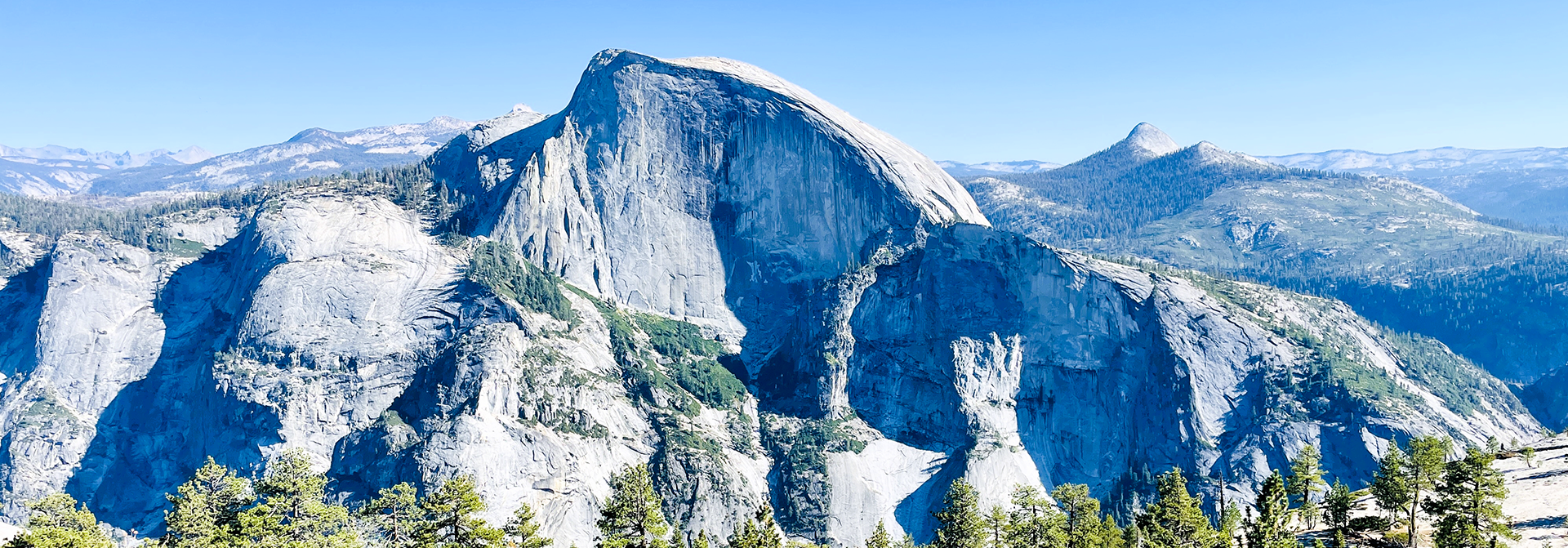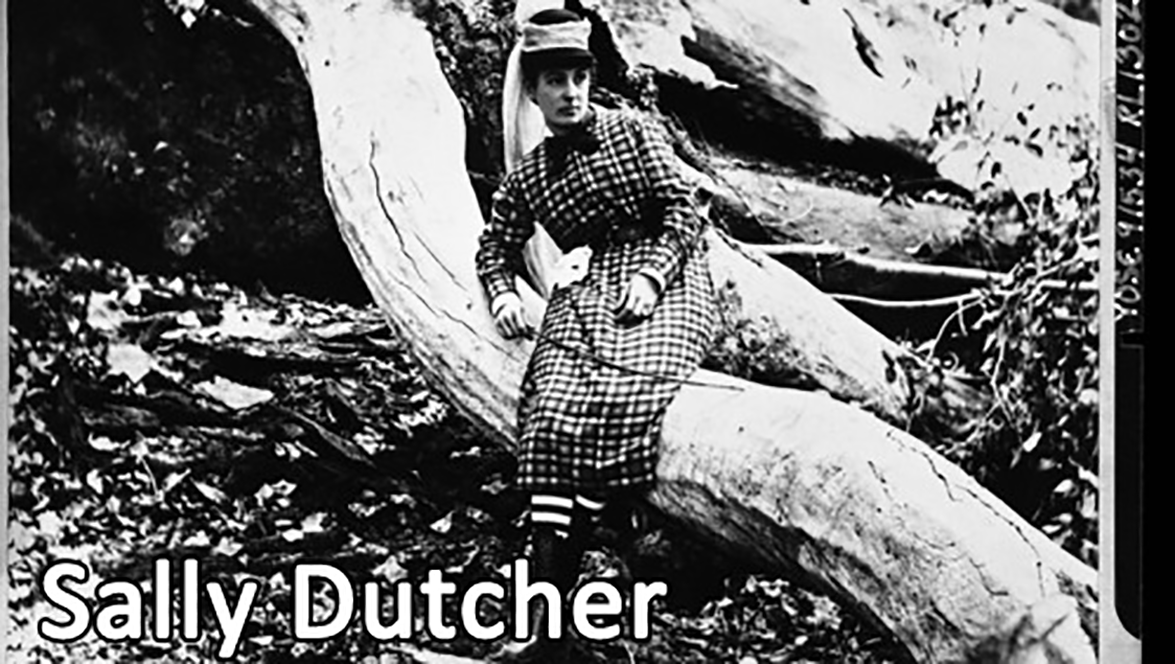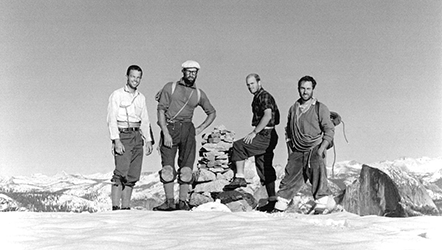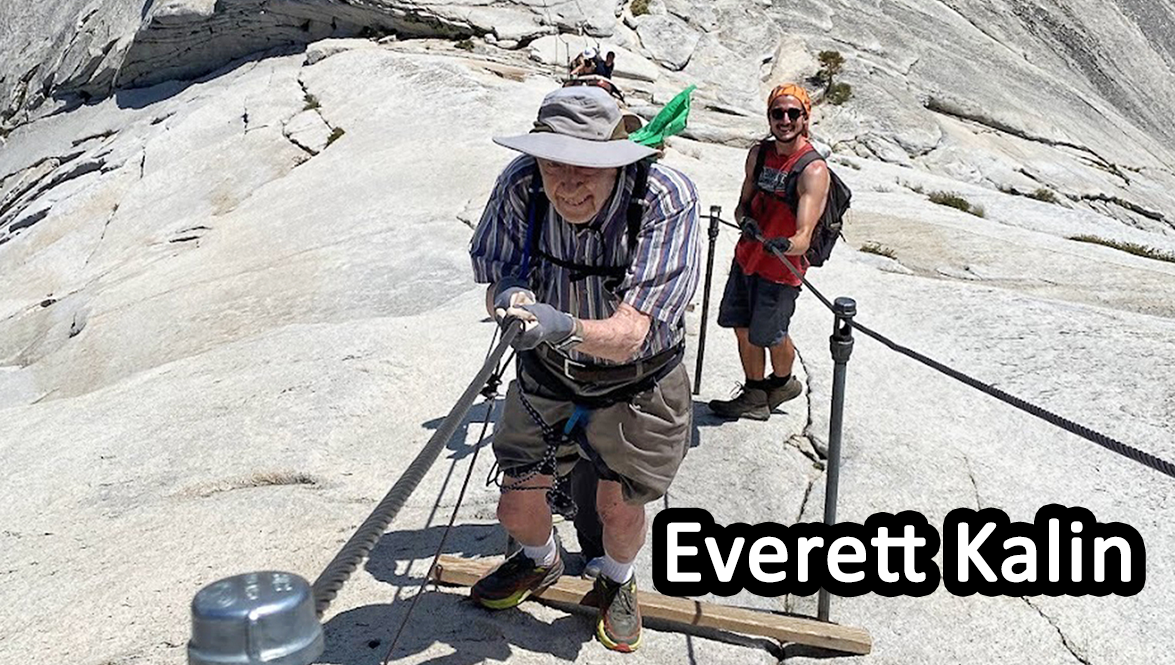Yosemite Planet - Half Dome

Half Dome - Strenuous Hiking -PERMIT REQUIRED
First things first: The 14- to 16-mile round-trip hike to Half Dome is not for you if you're out of shape or unprepared.
You will be gaining elevation (for a total of 4,800 feet) most of your way to the top of Half Dome. Most would say the reward is worth the effort. Along the way, you'll see outstanding views of Vernal and Nevada Falls, Liberty Cap, Half Dome, and—from the shoulder and summit—panoramic views of Yosemite Valley and the High Sierra.
Most hikers take 10 to 12 hours to hike to Half Dome and back; some take longer. If you plan on hiking during the day, it's smart to leave around sunrise (or earlier) and then have a non-negotiable turn-around time. For instance, if you haven't reached the top of Half Dome by 3:30 pm, you will turn around. Check for sunrise and sunset times before you hike. Regardless, each person should carry a good flashlight or headlamp with extra batteries (your cell phone doesn't count). Hikers commonly struggle down the trail after dark because they don't have a good light. Although the trail is well marked, you should be prepared with a good topographic map and compass and know how to use them.
Half Dome Permits for Day Hikers
Permits to hike to the top of Half Dome are required seven days per week when the cables are up (as called for in the Half Dome Plan in order to protect wilderness character, reduce crowding, protect natural and cultural resources, and improve safety). The cables are normally up from Memorial Day weekend (late May) to Columbus Day (early October).
A maximum of 300 hikers are allowed (about 225 day hikers and 75 backpackers) each day on the Half Dome Trail beyond the base of the subdome.
Permits for Backpackers (including Camping in Little Yosemite Valley)
Backpackers—including those who want to spend the night in Little Yosemite Valley—should apply for Half Dome permits with their wilderness permit.
Backpackers beginning a wilderness trip outside Yosemite should apply for Half Dome day hiker permits using the information on this page.
Permits are distributed by lottery via Recreation.gov, with one preseason lottery with an application period in March and and daily lotteries during the hiking season.
Backpackers—including those who want to spend the night in Little Yosemite Valley—should apply for Half Dome permits with their wilderness permit rather than using the process described below.
On each preseason lottery application, people can apply for up to six permits (six people) and for up to seven dates. Applications will only be successful if the number of permits requested is available on at least one of the requested dates. If enough permits are available for more than one of the requested dates, permits will be automatically awarded to the highest priority date, as entered by the applicant. The applicant must specify the name of the trip leader and may specify the name of an alternate. Each person may apply as a trip leader only once per lottery. People applying multiple times as trip leader will have all their lottery applications canceled. Permits will only be valid if the trip leader and/or alternate specified on the permit is part of the group using the permits. The group with trip leader or alternate must be present together at the base of the subdome, where rangers will check for permits. The names of the trip leader and alternate may not be changed once the application is submitted, and their permits are not transferable.
To apply for a permit, visit Recreation.gov or call 877/444-6777 (call center is open from 7 am to 9 pm Pacific time; online requests can be made any time during a lottery period).
Click on the link below to download information on hiking Half Dome and obtaining a permit
RECREATION.GOV

Who Has Climbed Half Dome?
Half Dome became a hiking trail through a process of first ascent, route development, and subsequent use by many.
George Anderson made the first ascent in 1875 by drilling eye bolts into the rock and attaching ropes, which became the precursor to today's cable route. This paved the way for others to follow, and over time, the trail became a popular destination for hikers.
Sally Dutcher became the first woman to climb Half Dome in October 1875, accompanied by George Anderson and Galen Clark. She worked as an assistant to photographer Carleton Watkins in his gallery
Royal Robbins, Jerry Gallwas, and Mike Sherrick (1957): This team made the first ascent of the Northwest Face, a significant achievement in big wall climbing.
Liz Robbins (1967): Liz Robbins became the first non-Native woman to climb a Grade VI big wall, the Northwest Face of Half Dome.
Recent Notable Ascents: Alex Honnold (2008): Honnold free soloed the Regular Northwest Face, a feat that brought him international recognition. Everett Kalin (2023). At 93 years old, Kalin became the oldest person known to have summited Half Dome. Tori Tibbs (2024). At 9 years old, Tori Tibbs accomplished the Half Dome hike, demonstrating the range of ages that can successfully complete the climb.

Trails that lead to Half Dome
On your way to climb Half Dome, you will be hiking the Mist Trail (shuttle stop 16) and passing through the Vernal & Nevada Falls, then Little Yosemite Valley. To proceed directly to the top of Vernal Fall, follow the Mist Trail 0.5 mile (0.8 km) up a steep granite stairway of over 600 steps. Prepare for slippery footing and a tremendous amount of waterfall spray in spring and early summer. The top of Nevada Fall may be reached by continuing 1.3 miles (2.1 km) along the Mist Trail. Nevada Fall may also be reached via the John Muir Trail (bypassing Vernal Fall). Portions of the John Muir and Mist Trails are closed in winter due to hazardous conditions. You are half-way to Half Dome!
Half Dome (Cables typically up from late May to early October) via Mist Trail 14 mi/22.5 km round-trip; via John A permit is required to summit Half Muir Trail 16.3 mi/26.3 km round-trip; via Mist and John Muir Trails 15.2 mi/24.4 km round-trip; Dome 10 to 12 hours; 4,800 ft./1,463 m. elevation gain. Begin at Happy Isles (shuttle stop #16) DO NOT BEGIN THIS ASCENT IF: 1) the cables are down, 2) there is any chance of rain (moisture makes the granite too slick for safety), or 3) there is any chance of lightning. Follow the Mist Trail or John Muir Trail to Nevada Fall. Continue on the trail, following the signs to Half Dome. The last 900 feet (275 m) of trail is a very steep climb up the east side of Half Dome. Cables assist hikers on the fnal 400 feet (122 m). They consist of two steel cables, about 3 feet apart and suspended waist high from pipes set in the rock. The top of Half Dome is a fairly large and level open surface. Camping is not permitted on top of Half Dome.

Preperation
Footwear: Bring well broken-in boots with good ankle support and good traction. Some of the most common injuries Half Dome hikers suffer are blisters and ankle injuries; good footwear is the best way to prevent these problems.
Gloves: Many people find it very helpful to wear sturdy gloves that have a very good grip on the cables. However, if you bring your gloves up, pack them out. Hundreds of pounds of rotting gloves otherwise accumulate.
Trash: There is no trash service on trails. While hiking in Yosemite, be sure to pack out all trash. When possible, you can help park rangers by picking up trash that you encounter on the trail. Bearproof trash cans are available at trailheads.
Water: One of the easiest ways to ensure a safe, enjoyable hike is to be sure to have plenty of water.
Weather conditions and personal preference affect the amount of water you need, but suggested minimum amounts per person are:
1 gallon (4 liters) if hiking to the top of Half Dome
2 quarts (2 liters) if hiking only to the top of Nevada Fall
1 quart (1 liter) if hiking only to the top of Vernal Fall
The only treated water on the trail is available (summer only) at a drinking fountain at the Vernal Fall Footbridge (less than a mile from the trailhead). Merced River water is available up to Little Yosemite Valley, however you should treat this water by boiling, using iodine, or using a giardia-rated water filter. Drinking untreated river water may cause significant illness.
Restrooms: Flush toilets are available at the Vernal Fall Footbridge (below Vernal Fall). Composting toilets are available near Emerald Pool (above Vernal Fall), near the top of Nevada Fall, and in Little Yosemite Valley.
At any other location, you are required to bury any solid human waste at least six inches (15 cm) deep and at least 100 feet (30 m) from water or trails. Pack out toilet paper.